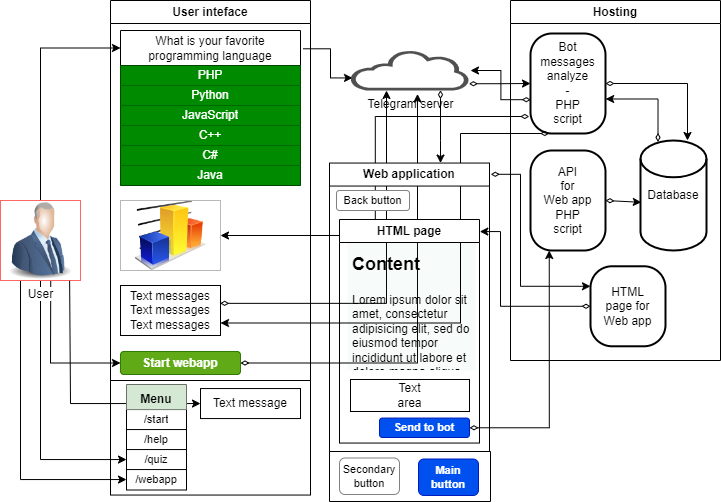The goal of the project: to study the basic capabilities of Telegram chatbots. Implemented functions:
- Creating a command menu
- Creating an inline keyboard
- Sending messages to the bot
- Receiving messages, commands and callbacks
- Creating questionnaires and receiving graphical results
- Recording all activity in the database
- Deleting messages from the bot
- Launching the telegram web application
- Communicating with the web application
The bot is available at link
Libraries used: irazasyed (basic for working with telegram), jpgraph (for creating a graph), the web application is made in the form of a regular HTML page, JQuery and JQuery UI libraries are added to it.
The bot is serviced by a PHP program that runs on my hosting in a window (screen) of the operating system. The server requests messages every 5 seconds. I decided to make only this one option for now, so as not to lose messages in case of program or connection failures. The following general scheme works:

The algorithm is as follows: a PHP script requests new updates on the Telegram server via its API every 5 seconds, three commands are implemented in the input menu: brief information about the bot, a test questionnaire, and launching a web application. All messages from the server are recorded in the database, and the bot’s responses (i.e. the command handler) are also recorded. This allows you to regularly delete messages from the bot that have been there for more than 5 minutes.
|
|
At first, an attempt was made to make a questionnaire based on the Telegram poll, but it turned out that such questionnaires only work in one chat, that is, in groups or channels, in a simple bot the questionnaire will consist of one answer from a specific user and it is impossible to access the answers of other users, it is also impossible to issue the survey result in the form of a graph, that is, only one option is available: showing the questionnaire, the user’s answer and showing the graph from one indicator with a value of 100%. It was necessary to make a completely custom questionnaire and accept answers via an inline keyboard. In this version, the user is allowed to call the questionnaire as many times as he wants. The graph is created using the jpgraph library. The user will not be able to call the questionnaire again if he has the previous one open and it has not been automatically deleted within 5 minutes. |
| The web application is launched via inline-keyboards, i.e. the launch button is shown in the message area. This is done on purpose, since when the application is called via the keyboard in the input area, user information and the initData object are not transferred there. In addition, just in case, the chat_id and a link to the API script for processing actions inside the application are transferred to the application. The web application is a regular HTML page, but it must be called via HTTPS. | |
| An additional PHP script to provide the functionality of the application is necessary due to the fact that there is practically no connection between the application and the bot. The telegram javascript library has a sendData() method, but it only allows you to send some text to the interface input area and closes the application, in addition, the method is triggered only when the application is called via a button in the input area, that is, in this case, the application does not receive information about the user. Thus, if you need to give something to the bot from the application, you need to call the script with the API, it will write the message to the database and send a message to the telegram, which will be shown in the bot. If you do not write data to the database, this message will not be received by the main handler, telegram does not send such messages to updates. I did not find any outstanding commercial opportunities for the web application, this is an ordinary web page. The javascript library has many possibilities for using a smartphone, all other possibilities have not yet opened up for me in this study. | |




